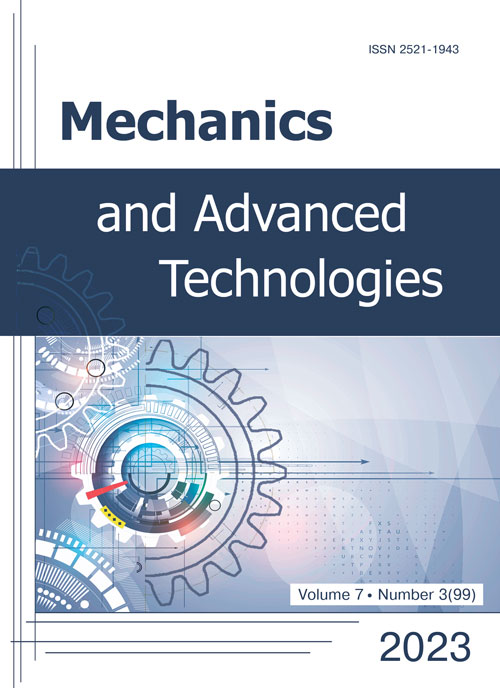Alternative technologies of composite of highly loaded aircraft structures: a qualitative method for making multicriteria decisions: Part III. Research of the methodological basis in decision-making: technological constructions in in the assessment toolki
DOI:
https://doi.org/10.20535/2521-1943.2023.7.3.293231Keywords:
AK, PKM, PKM/AK, VP, ADS, ATP, TP(e), CTR, interpretation, polyhedra, cellular spaces, cellular structures, quality-cost, criterion estimates, pyramid, circular cone, triangulationAbstract
The third part of the article proceeds from the starting points in the decision-making problem (DMP) specified in the first stages of research [1, 2]. Here, we continue to compare the predominance (first of all, quality) of autoclave and non-autoclave alternative technological processes (ATP) as part of the stages of TP(e) with a linear algorithm of end-to-end action in the manufacture of carbon fiber (CF) aircraft structures (AC) such as highly loaded wing stringer panels (HLS) of B787, A350, MC-21, CSeries mainline aircraft as a component of hierarchical systems. To describe and study them, the following were involved: initial technological and verbal models, technological and mathematical model of an autonomous dynamic system (ADS) and a number of two-dimensional manifolds (topology) to it in the form of technological and geometric models. The article continues the study of development in this direction by approximating manifolds by polyhedra. Including co-cellular and double-formed structures - pentagonal pyramids and bipyramids, as well as bodies of revolution around them - cone and bicon. Examples of schematic and technological interpretive modeling are presented. The methodological basis is the main provisions of decision-making theory, factor analysis and system-process approach with the involvement of practice results (expert analysis), first of all, the definition of technological factors of processes with criterion assessments of the advantages, components of alternatives in their competitive strategies.
References
- D. Kiva and V. Zabashta, “Alternative technologies of composite high-loaded aircraft constructions: a qualitative method of making multicriterial decisions. Part I. Initial stages in the problem of decision-making”, Mech. Adv. Technol., vol. 5, no. 2, pp. 203–211, Nov. 2021. DOI: https://doi.org/10.20535/2521-1943.2021.5.2.245000.
- V. Zabashta, “Alternative technologies of composite highly loaded of aircraft structures: a qualitative method of making multi-criteria decisions. Part II. Modeling in multi-criteria evaluation of alternatives”, Mech. Adv. Technol., vol. 6, no. 2, pp. 203–220, Oct. 2022. DOI: https://doi.org/10.20535/2521-1943.2022.6.2.265371.
- S. A. Smotrova and I. D. Simonov–Yemelyanov, “Effektivnye tekhnologii formirovaniya vysokonagruzhennykh aviatcionnykh konstruktsiy iz polimernykh kompozitcionnykh materialov”, Konstruktsii iz kompozitsionnykh materialov, no. 3, pp. 15–24, 2016.
- Ye. A. Veshkin, V. Yu. Postnov, M. V. Postnova and A. A. Barannikov, "Opyt primeneniya vakuum–infuzionnykh tekhnologiy v proizvodstve konstruktsiy iz PKM", Izvestiya Samarskogo nauchnogo tsentra Rossiyskoy akademii nauk, vol. 20, no. 4 (3), pp. 16-28, 2018.
- T. O. Tsaryova and O. V. Zozulyov, “Tekhnolohiya yak ekonomichna katehoriya”, Ekonomichnyy visnyk NTUU “KPI“: zbirnyk naukovykh prats, no. 6, pp. 345–351, 2009.
- O. B. Slyvinska, “Accounting and economic merit of “quality costs” and their classification”, Efficient economy, no. 4, 2015. Available: http://www.economy.nayka.com.ua/?op=1&z=3993.
- V. Lytvynenko, Udoskonalennya protsesu otsinky i yakosti vyrobiv iz kompozytsiynykh materialiv v aviabuduvanni. Kyiv: NAU, 2022, 98 p.
- G. Yu. Panina, Toricheskiye mnogoobraziya. Vvedeniye v algebraicheskuyu geometriyu, 2009, 45 p.
- V. G. Boltyanskiy and V. A. Yefrimovich, “Ocherk osnovnikh idey topologii (okonchaniye)”, Matem. prosv., vol. 6, pp. 107–138, 1981.
- Yu. G. Borisevich, N. M. Blizniakov, Ya. A. Izrailevich and T. I. Fomenko, Vvedeniye v topologiyu. Moskva: Vysshaya shkola, 1980, 295 p.
- A. Ye. Kononyuk, Diskretno–nepreryvnaya matematika. Kniga 8, chast 1: Vvedeniye v teoriyu prostranstv. Kyiv: Osvita Ukrainy, 2016, 619 p. Available: https://ecat.ust.edu.ua/ft/Spaces1.pdf.
- Yu. G. Reshetnyak, “Dvumernye mnogoobraziya ogranichennoy krivizny”, Itogi nauki i tekhniki. Seriya “Sovremennye problemy matematiki. Fundamentalnye napravleniya“, vol. 70, pp. 7–189, 1989.
- M. Khirsh, Differentsialnaya topologiya. Moskva: Mir, 1979, 280 p.
- O. O. Pryshlyak, Topolohiya mnohovydiv. Kyiv: KNU, 2013, 83 p. Available: https://www.mechmat.univ.kiev.ua/wp-content/uploads/2018/03/topolog_pryshljak.pdf.
- A. T. Fomenko, Naglyadnaya geometriya i topologiya: matematicheskiye obrazy v realnom mire. Moskva: MGU, 1998, 416 p.
- Yu. V. Skvortsov, Konspekt lektsiy po distsipline “Mekhanika kompozitsionnykh materialov”. Samara: SGAU, 2013, 94 p.
- O. V. Andrieiev, Naukovi osnovy pidvyshchennya efektyvnosti stvorennya konstruktsiyi transportnykh litakiv z polimernykh kompozytsiynykh materialiv na etapakh zhyttyevoho tsyklu vyrobu. Kyiv: NAU, 2020, 333 p.
- ISO 9000-1. Rukovodstvo po vyboru i primeneniyu sistemy obespecheniya kachestva.
- ISO 9000-4. Zhiznennyy tsikl produktsii "Petlya kachestva".
- DSTU 3021-95. Vyprobuvannya i kontrol yakosti produktsiyi. Terminy i vyznachennya.
- Yu. Ya. Amirov, Nauchno-tekhnicheskaya podgotovka proizvodstva. Kyiv: Ekonomika, 1989, 230 p.
- V. F. Zabashta, “Tekhnicheskaya podgotovka proizvodstva izdeliy iz kompozitsionnykh materialov”, in Nauchnaya entsiklopediya po mashinostroyeniyu, vol. 10. Moskva: Mashinostroyeniye, 2006, pp. 104–142.
- Matsuo Komatsu, Mnogoobraziye geometrii. Moscow: Znaniye, 1981, 208 p.
- D. P. Frolov, “Mnogourovnevaya iyerarkhiya ekonomicheskogo prostranstva”, Prostranstvennaya ekonomika, no. 4, pp. 122–150, 2013.
Downloads
Published
How to Cite
Issue
Section
License
Copyright (c) 2023 Володимир Забашта

This work is licensed under a Creative Commons Attribution 4.0 International License.
Authors who publish with this journal agree to the following terms:
- Authors retain copyright and grant the journal right of first publication with the work simultaneously licensed under CC BY 4.0 that allows others to share the work with an acknowledgement of the work's authorship and initial publication in this journal.
- Authors are able to enter into separate, additional contractual arrangements for the non-exclusive distribution of the journal's published version of the work (e.g., post it to an institutional repository or publish it in a book), with an acknowledgement of its initial publication in this journal.
- Authors are permitted and encouraged to post their work online (e.g., in institutional repositories or on their website) prior to and during the submission process, as it can lead to productive exchanges, as well as earlier and greater citation of published work











